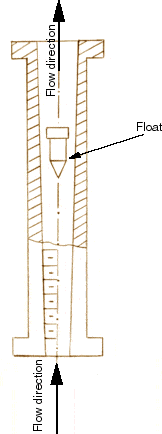Variable area flow meters work by allowing the cross sectional area of the device to vary in response to the flow, causing some measurable effect that indicates the flow measurement. Flow through the opening moves an internal float up the area chamber. The external body of this chamber is scaled in flow units for each application. When the flow increases, the fluid generates more force and moves the float farther up the internal chamber body.
The most common type is a variable area flow meter in a vertical metering tube that balances the downward weight of a float with the upward force of the flowing fluid. A spring instead of a float allows this type of flowmeter to be installed in horizontal pipes, because the functioning of the float is not dependent upon gravity when the spring is used. These flowmeters are called variable area metal tube flow meters and may be read locally because their metering tubes have markings that relate the position of the float (that can be seen) with the flow rate of the fluid. Flowmeters with remote signals are typically constructed with metal tubes, and include a flow transmitter that senses the height of the float to determine fluid flow.
Other types of variable area flow meters include vane-style, which have spring-opposed vanes that move in relation to the flow rate. Piston type variable area flowmeters use spring-opposed pistons that move in relation to flow rates and are less sensitive to viscosity than vane-type variable area flowmeters. Both vane and piston variable area flowmeters can be connected to a flow transmitter for display reading or producing analog and digital outputs and various contact outputs.
Variable area flowmeters must be used with clean fluids but they are versatile enough to measure liquids, gases, or steam. Variable area flowmeters are used as an inexpensive alternative to other flow meters for purging and process applications for fluids as water, de-ionized water, compressed air, chemicals, paint, lubrication oil, brine, and sampling systems to verify and adjust system flow rates. Corrosive liquids can be measured with various liner materials such as PTFE and others. However, the variable area flowmeter has a limited turn-down with accuracies that are lower than other technologies.
See below for a typical VA Meter Design:
Request a quote on variable area flow meters, or contact SmartMeasurement to learn more.

